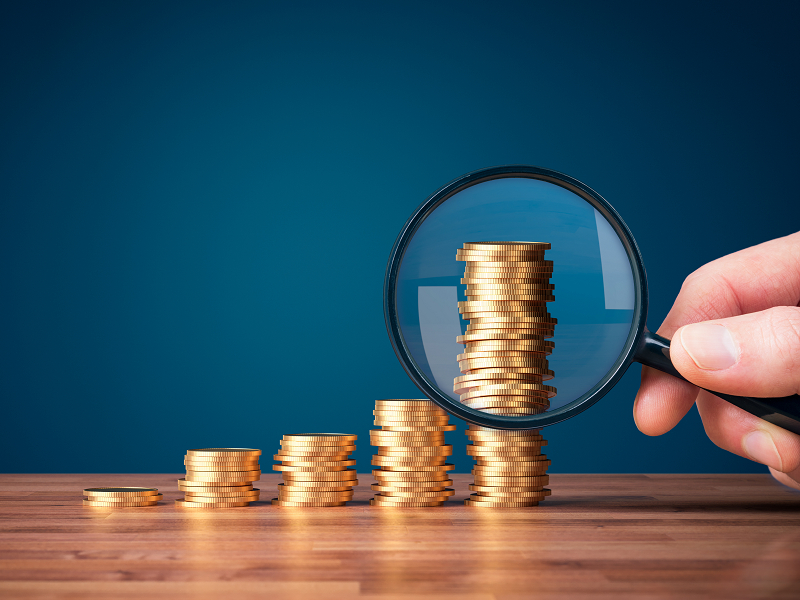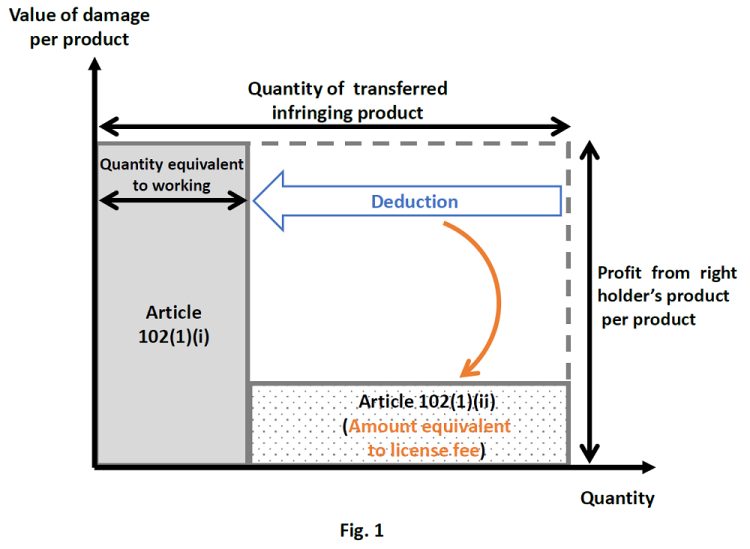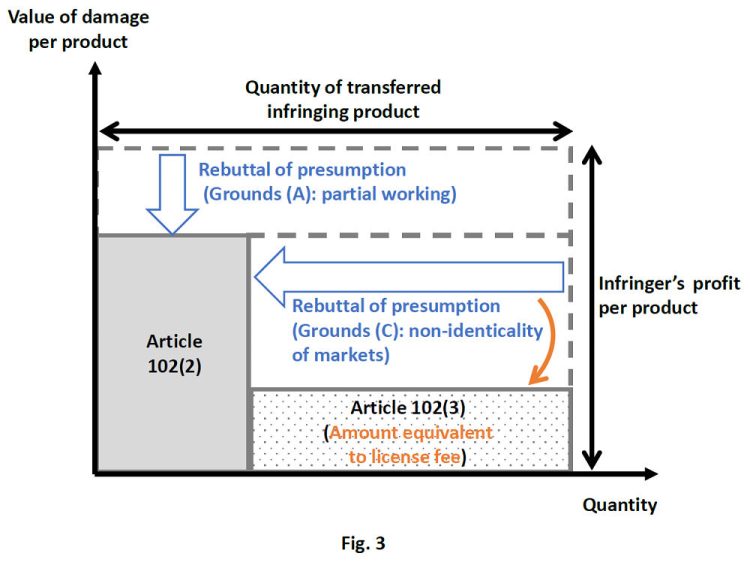2023.04.19 Patent
Introduction of Court Case Indicating Possible Increase in Damages

1. Introduction
The value of damage caused by patent infringement is difficult to prove due to its nature. Thus, as we introduced in our article dated November 21, 2022, Article 102 of the Japanese Patent Act stipulates presumption of the value of damage caused by patent infringement in order to reduce difficulties in presentation of evidence by right holders.
In this article, we would like to introduce a decision of the Special Division (Grand Panel) of the Intellectual Property High Court (IP High Court) to allow application of the presumption under Patent Act Article 102(3) for calculating the value of damage caused by patent infringement concerning the rebutted portion of the presumption under Article 102(2). Since it is not clearly stated in the article concerning whether such a superimposed application of Patent Act Article 102(2) and 102(3) may be allowed, there had been different interpretations regarding this matter. The decision provides the criteria for determining whether the superimposed application can be allowed. We believe that such criteria would be helpful in the future and thus would like to introduce this decision to you.
2. Provision for Presumption of Value of Damage (Patent Act Article 102)Introduction
As shown in Fig. 1 below, Patent Act Article 102(1)(i) stipulates that “(the amount of profit per unit of the right holder’s product) × (the quantity of infringing product transferred by the infringer)” may be determined to be the value of damage. However, a quantity exceeding the quantity equivalent to the right holder’s ability to work the patented invention and, if there are any circumstances where the right holder could not sell the product, the quantity equivalent to the circumstances are deducted from the quantity of the transferred infringing product. Regarding the deducted quantity, Article 102(1)(ii) stipulates that the right holder may claim for the amount equivalent to a license fee except the cases where it is not acknowledged that the right holder could have granted a license. Article 102(1)(ii) is a provision added in the legal revision in 2019. The right holder may claim for the sum of the amount under Article 102(1)(i) and the amount under Article 102(1)(ii) against the infringer.

As shown in Fig. 2 below, Article 102(2) stipulates that “the amount of profit of the infringer” is presumed to be the value of damage. It is understood that this presumption is partly or fully rebutted if there are grounds for rebuttal—specifically, if there are circumstances where the causal relationship between the damage and the acts of infringement is denied. However, unlike Patent Act Article 102(1)(ii), it is not clearly stated whether it is possible to claim for the amount equivalent to a license fee, i.e., whether Article 102(3) is also applicable, regarding the rebutted portion of the presumption under Article 102(2).

3. Introduction of Court Case: IP High Court, Case No. 2020 (Ne) 10024, “Chair-Type Massage Machine” Case (Decision rendered on October 20, 2022)
(1) Overview
This is a case where the Appellant, the patentee of two patented inventions titled “Chair-type massage machine” etc. (Patent No. 4504690 and No. 4866978), asserted that the Appellee’s manufacturing, sales, etc. of the product constituted infringement of the above patent rights, seeking an injunction on manufacturing, sales, etc. of the product and disposal of the product against the Appellee, and claiming for damages. In the present case, one of the points in dispute was the value of damage that the Appellee should compensate the Appellant.
(2) Arguments of the Parties to the Case regarding the Point in Dispute
[Appellant’s Argument]
The Appellant claimed for damages under Patent Act Article 102(2).
In response to the Appellee’s arguments about the grounds for rebuttal of the presumption, the Appellant contended that all the arguments lack basis. The Appellant also contended that, even if the presumption under Article 102(2) is rebutted, it should be construed that, for the damage related to the rebutted portion, it is possible to claim for damages equivalent to the amount of a license fee under Article 102(3).
[Appellee’s Argument]
The Appellee argued that the presumption under Patent Act Article 102(2) should be rebutted for the five grounds listed below:
(A) Fact that the present patented inventions are worked only in a part of the Appellee’s product;
(B) Existence of competing products in the markets;
(C) Non-identicality of the markets;
(D) Appellee’s marketing efforts (brand power and advertising); and
(E) Performance (features other than those of the patented inventions such as functions, design, etc.) of the Appellee’s product.
In particular, the Appellee asserted regarding ground (A) that the patented inventions relate to “a forearm treatment mechanism” of a chair-type massage machine and are worked only in a part of the massage machine of the Appellee’s product; therefore, the presumption under Article 102(2) should be rebutted.
Also, the Appellee asserted regarding ground (C) that only some of the destination countries (export destinations) of the Appellee’s product and the Appellant’s product are in common, and that different destination countries mean different markets, in other words their products are not competitive in the markets; therefore, the presumption under Article 102(2) should be rebutted.
(3) Decision of the Court
(The decision excerpted below is summarized by the editor to facilitate understanding.)
The court held that, grounds (A) and (C) above, out of those contended by the Appellee, are found to constitute the grounds for rebuttal of the presumption.
• With regard to ground (A)“It cannot be said that the technical significance of the present patented inventions in the Appellee’s product is high, and thus it should be said that the contribution of the patented inventions towards forming motivation to purchase the Appellee’s product is limited. The amount of marginal profit gained by the Appellee from export of the product is found to include an amount to which the patented inventions did not contribute. The fact that the present patents are worked only in a part of the Appellee’s product constitutes the grounds for rebuttal of the presumption.”• With regard to ground (C)“Among the destinations of the Appellee’s product, in respective markets of those destination countries to which the Appellant’s product is not exported, it cannot be said that there is a competitive relationship where the Appellant could have exported the Appellant’s product but for the export of the Appellee’s product. That is, it should be said that there was no relationship between export of the Appellee’s product and decrease in sales of the Appellant’s product. Accordingly, it is acknowledged that the Appellee’s product and the Appellant’s product were not in the same markets to the extent of different destination countries. The fact that some of the Appellee’s product are exported to countries where the Appellant’s product is not exported constitutes the grounds for rebuttal of the presumption.”
Further, the court held as described below that, considering that the patentee may gain profits by directly working the patented inventions and also by granting a license for working the patented inventions to a third party, it should be understood that, even in a case where the presumption under Patent Act Article 102(2) is rebutted, Article 102(3) is applicable based on acknowledgement that the patentee could have granted a license for the rebutted portion of the presumption. In the present case, the court held that regarding the rebutted portion of the presumption based on the non-identicality of the markets stated in (C) above, the Appellant could have granted a license and thus allowed application of Article 102(3) (claim for the amount equivalent to a license fee).
“It is construed that the damage the patentee sustained as a result of the acts of infringement can be acknowledged as lost profits due to the decrease in sales of the product that the patentee could have directly sold, etc. but for the infringement, and as profits that the patentee should have gained due to the loss of opportunity to grant a license. It should be construed that, even in a case where the presumption under Patent Act Article 102(2) is rebutted, Article 102(3) is applicable based on acknowledgement that the patentee could have granted a license for the rebutted portion of the presumption.”“Grounds for rebuttal of the presumption under Patent Act Article 102(2) are regarded to include grounds for rebuttal due to the quantity of sales, etc. of the infringing product beyond the patentee’s ability to work the patented invention, and grounds for rebuttal due to circumstances where the patentee could not sell, etc. the product for other reason(s). With regard to the rebutted portion of the presumption based on the former, it is acknowledged that the patentee could have granted a license but for the special circumstances. On the other hand, with regard to the rebutted portion of the presumption based on the latter, it should be determined individually whether the patentee could have granted a license.”“Neither of the grounds for rebuttal of the presumption (stated in (A) and (C) above) in the present case are those due to the quantity beyond the patentee’s ability to work the patented inventions.The grounds for rebuttal of the presumption due to the non-identicality of the markets (stated in (C) above) are based on the finding that the Appellant’s product is not acknowledged, from the difference in the destination countries of the Appellant and those of the Appellee, to be in such a competitive relationship where the Appellant’s product could have been exported but for the export of the Appellee’s product. With regard to the quantity of exported machines related to the rebutted portion of the presumption, although it can be said that there were circumstances where the Appellant could not directly export the product, the Appellant is found to have been able to grant a license.On the other hand, with regard to the grounds for rebuttal of the presumption due to the fact that the present patented inventions are worked only in a part of the infringing product (stated in (A) above), the Appellant is not found to have been able to grant a license for the part to which the patented inventions do not contribute.Therefore, it is reasonable in the present case to allow application of Patent Act Article 102(3) only for the rebutted portion of the presumption based on the grounds due to the non-identicality of the markets (stated in (C) above).”

4. Conclusion
We believe that the decision described above is significant in that the decision clearly indicates that Patent Act Article 102(3) may be applicable to the rebutted portion of the presumption under Article 102(2), and thereby the value of damage may be presumed higher. It would be particularly helpful in the future that, to determine whether application of Patent Act Article 102(3) would be allowed in addition to application of Article 102(2), the decision has provided the criteria for determining whether the right holder could have granted a license, and has indicated that the non-identicality of the markets due to a difference in destinations constitutes a specific example where a license could have been granted. Considering the fact that the above decision was made by the Grand Panel of the IP High Court, we think that it is relatively highly likely that the determination method provided in the above decision would be followed from now on. Perhaps, similarly to the addition of Article 102(1)(ii) in the legal revision in 2019, which clearly states that a superimposed application of Article 102(3) may be allowed, a comparable provision may be also added to Article 102(2). We would like to continue to closely monitor future trends.
Edited by Hiroko Iwatsuki
